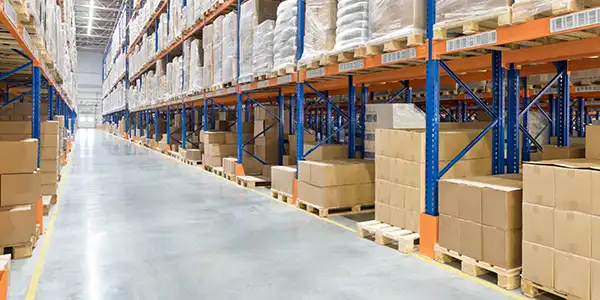#AskCentiMark Series: Key considerations for roofing in the warehouse and manufacturing industry.

Hi again, it’s Anne Serzz! When it comes to roofing warehouse and manufacturing facilities, there are numerous challenges that businesses may face, from severe weather to operational downtime. In this blog, we’ll explore key considerations for roofing materials, maintenance strategies and how to manage challenging roofing projects while prioritizing safety for such facilities. Whether you're managing a warehouse or in charge of a large portfolio of manufacturing facilities, this blog has the answers you’re looking for!
To dive deeper into these challenges and best practices, we sat down with CentiMark’s Clint Snowden, Director of Global Accounts and Bradley Ferguson, Vice President of Sales in the Mid-Central Region in the United States. Let’s get started on navigating roofing projects in these complex environments:
-
Q: What are the most common roofing challenges your warehouse and manufacturing customers face and how do you address them?
Clint: One of the biggest challenges in the warehouse and manufacturing industry is understanding how the building’s location and internal operations affect roofing needs. For example, a facility in Texas will face different challenges from those in Wisconsin due to contrasting climate pressures. We always want to carefully assess both the external environment and the specific operational needs of each facility to come up with optimal roofing solutions. This helps ensure the roof system we recommend will protect the product inside and withstand the unique conditions of the location.
Brad: Agreed! I also think working around their schedule is a crucial challenge because every minute counts towards profit. These facilities generally maintain operations 24/7, seven days a week, so we really need to work around their schedule to minimize disruptions to their business operations. For example, if a shift ends at 4:00 pm, we’ll work around that by setting up after they get off or even tackling the job over the weekend. We always make sure to set up, tear down and remove equipment at times that work best for them!
-
Q: What are some key considerations customers should account for when selecting roofing materials for these types of facilities?
Clint: There is no “one size fits all” for material recommendations because every facility has unique needs. However, there are certain aspects we want to consider when recommending roofing materials such as where they’re located and what they’re doing inside. I would say about 70% of all materials going down right now are TPO roof systems but it certainly varies by customer. The attachment method comes into play as well! For example, some may look for a roof system adhered to accommodate their solar arrays. Overall, we want to consider their location, typical weather patterns, operational needs, indoor temperature and more to develop the best roofing solutions possible.
-
Q: What maintenance strategies do you recommend for customers to avoid major roof damage or leaks that result in inventory loss and operational downtime?
Brad: You will want to conduct routine inspections when the seasons change and after severe weather events. Aside from that, we want our customers to realize that you can’t just rely on your warranty to ensure long-term performance. Committing to regular cleaning and completing any minor repairs before they turn into bigger, costly problems is key. In order to simplify that process, you need to find a contractor, such as CentiMark, that can manage your entire portfolio’s maintenance so you can focus on your business.
-
Q: How do environmental factors like regional climate influence your roofing recommendations for warehouse and manufacturing buildings?
Clint: Weather conditions, like storms or extreme temperatures, can greatly impact the timing and approach of a roofing project for these types of facilities. For example, when removing a roof this includes the insulation and in sensitive environments like cold storage could lead to thawing and energy loss. In colder climates, we carefully plan around the winter months to avoid excessive heat loss, while in warmer areas, we schedule work to avoid overheating around the summer months. Overall, our main goal is to minimize the impact on operations.
-
Q: Can you share a challenging roofing project you’ve worked on in a manufacturing or warehouse setting and how you successfully managed it?
Brad: One of the most challenging roofing projects for us was for an aerospace company with multi-million dollar machines that couldn’t tolerate any debris. We had to build platforms and use roofing membranes to build interior protection over sensitive equipment during the project. After performing the work on the roof, we'd return to disassemble the platforms and interior protection. By scheduling this work in the summer to avoid weather delays, we were able to complete the project smoothly and keep the equipment protected around the clock.
-
Q: How do you approach roof safety and management when working for warehouse and manufacturing facilities with multiple locations around the country?
Brad: Safety should be a top priority, especially when working with warehouse and manufacturing facilities across multiple locations! At CentiMark, we collaborate closely with each facility’s Environmental Health and Safety (EHS) team to understand and meet their specific requirements. After the initial discussions, we develop a customized safety plan for each site. This plan is reviewed by our branch and regional safety managers, as well as the client’s safety team. We always reinforce safety at our pre-job meetings with our crews and the client’s team to ensure everyone is aligned and on the same page.
As you can see, roofing for warehouse and manufacturing facilities comes with its fair share of challenges but CentiMark will keep things running smoothly. Whether it’s choosing the right materials, working around your busy schedule or coming up with a Preventative Maintenance Plan, it all comes down to finding the right partner to get the job done right. As Clint and Brad mentioned, making sure you have a solid course of action will make all the difference in keeping your facility protected and your operations on track!
About our panel:
Clint Snowden:
With almost 20 years of roofing experience under his belt, Clint has successfully managed projects for a wide range of well-known manufacturing and warehousing brands. He has a deep understanding of the unique needs of these industries.
Bradley Ferguson:
Bradley has been with CentiMark for over 35 years and oversees roofing projects for warehouse and manufacturing facilities in five different states. His wealth of experience working with these facilities has allowed him to develop customized roofing solutions.
When you subscribe to the blog, we will send you an e-mail when there are new updates on the site so you wouldn't miss them.
